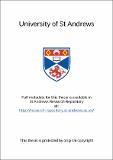Files in this item
Mechanisms of G2 chromosomal radiosensitivity of murine SCID cells
Item metadata
| dc.contributor.advisor | Bryant, Peter Edward | en |
| dc.contributor.author | Finnegan, Clodagh E. | en |
| dc.coverage.spatial | 263p | en |
| dc.date.accessioned | 2021-04-08T09:04:14Z | |
| dc.date.available | 2021-04-08T09:04:14Z | |
| dc.date.issued | 2001 | |
| dc.identifier.uri | https://hdl.handle.net/10023/22003 | |
| dc.description.abstract | The non-homologous end-joining (NHEJ) pathway of DNA repair has become a recent focus of attention and one of the central players of this pathway is DNA-PKCs which is mutated in murine Severe Combined Immunodeficiency (SCID). The underlying mechanisms of the variable G2 chromosomal radiosensitivity in different individuals or cell lines has been the subject of much discussion, and the use of mutant radiosensitive rodent cell lines has provided a way to begin to understand the genetics and mechanisms of chromosomal radiosensitivity. As an example of this approach SCID cells have shown an elevated G2 chromosomal response to ionising radiation (IR). This response is generally thought to be caused by the underlying double-strand break (dsb) rejoining deficiency. However, recently Bryant (1998) proposed the signal model suggesting that G2 radiosensitivity is not directly related to dsb rejoining, but is due to an enhanced conversion of dsb to chromatid breaks via a recombinational mechanism. Therefore, the aim of the work presented in this thesis was to increase our understanding of the relationship between dsb and chromatid breaks in the G2 phase of the cell cycle. The cell lines used in this research were murine fibroblastic SCID, normal CB17, 100E+ (hybrid SCID cells complemented for DNA-PKcs) and 50D⁻ (hybrid non-complemented SCID) cells. The kinetics of the disappearance of chromatid breaks with time in G2 SCID and CB17 (normal wildtype) cells after gamma-irradiation showed a similar rate in the two cell lines. However, there was a 1.3-1.7 fold elevated frequency of chromatid breaks in SCID relative to CB17 cells. Analysis of dsb induction in SCID and CB17 cells showed similar initial frequencies of dsb. Analysis of dsb rejoining showed a higher residual frequency of dsb in SCID compared with CB17 cells from 10 min up to 3h, which appeared to be correlated with the observed elevated frequencies of chromatid breaks. However, further experiments involving treatment of irradiated G2 cells with the DNA synthesis inhibitor 9- β-D arabinofuranosyladenine (araA) enhanced the frequency of chromatid breaks without showing a significant effect on dsb rejoining as measured by constant field gel electrophoresis. Thus, while acknowledging the conflicting nature of these results, the araA experiments throw serious doubt upon the direct relationship between the two end-points. The reasons for these results are not at present clear and further investigation is obviously required. However, a mechanism such as that recently proposed under the signal model, where dsb are not directly involved in chromatid break formation might offer a possible explanation, namely that araA acts on the semi-final stage in the recombinational rearrangement leading to chromatid breaks. Another factor influencing the induction of chromatid breaks was the end-structure of dsb, and this was more pronounced in SCID than normal cells, as shown by an elevated frequency of chromatid breaks in response to restriction endonucleases (RE) inducing blunt- and 3' cohesive-ends compared to those inducing 5' cohesive ends. These results suggest the molecular configuration of the dsb influences the mechanism by which dsb are converted to chromatid breaks. Furthermore, the chromatin structure of SCID and CB17 cells was studied by flow cytometry of nucleoids under various conditions and the results revealed differences between the two lines. In addition, SCID nucleoids were in general more compact, an effect possibly correlated with an observed reduction in overall chromosome length. | en |
| dc.language.iso | en | en |
| dc.publisher | University of St Andrews | en |
| dc.subject.lcc | QH465.R3F5 | |
| dc.subject.lcsh | DNA repair | en |
| dc.subject.lcsh | Severe combined immunodeficiency | en |
| dc.title | Mechanisms of G2 chromosomal radiosensitivity of murine SCID cells | en |
| dc.type | Thesis | en |
| dc.type.qualificationlevel | Doctoral | en |
| dc.type.qualificationname | PhD Doctor of Philosopy | en |
| dc.publisher.institution | The University of St Andrews | en |
This item appears in the following Collection(s)
Items in the St Andrews Research Repository are protected by copyright, with all rights reserved, unless otherwise indicated.

